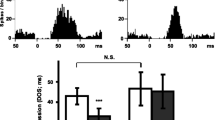Abstract
The effects of repeated electroconvulsive shock on the 5-HT uptake site were studied in rat cortex using [3H]-paroxetine binding. This ligand was used because it is thought to directly label the 5-HT uptake site, whereas [3H]-imipramine may bind to a presynaptic recognition site different from the uptake site. No changes were found in the maximum number of [3H]-paroxetine binding sites and equilibrium dissociation constant after repeated electroconvulsive shock, whereas a parallel investigation of β-adrenoceptor binding showed the expected decrease in receptor number.
Similar content being viewed by others
References
Barkin AI (1986) Interactions of drugs and electroshock treatment on cerebral monoaminergic systems. In: Malitz S, Sackeim H (eds) Electroconvulsive therapy: clinical and basic research issues. In: Malitz S, Sackeim H (eds) Electroconvulsive therapy: clinical and basic research issues. Ann NY Acad Sci 462:1478162
Bradford MM (1976) A rapid method for the quantitation of microgram quantities of protein utilizing the principle of proteindye binding. Anal Biochem 72:248–254
Briley M (1985) Imipramine binding: relationship with serotonin uptake and depression. In: Green AR (ed) Neuropharmacology of serotonin. Oxford University Press, New York Toronto Melbourne, pp 50–78
Buus Lassen J, Lund J, Sondergaard I (1980) Central and peripheral 5-HT uptake in rats treated chronically with femoxetine, paroxetine and chlorimipramine. Psychopharmacology 68:229–233
Crow TJ, Johnstone EC (1986) Controlled trials of electroconvulsive therapy. In: Malitz S, Sackeim H (eds) Electroconvulsive therapy: clinical and basic research issues. Ann NY Acad Sci 462:12–19
Evans JPM, Grahame-Smith DG, Green AR, Tordoff AFC (1976) Electroconvulsive shock increases the behavioural responses of rats to brain 5-hydroxytryptamine accumulation and central nervous system stimulant drugs. Br J Pharmacol 56:193–199
Fuxe K, Calza I, Benfenati F, Zini I, Agnati IF (1983) Quantitative autoradiographic localization of 3H-imipramine binding sites in the brain of the rat: relationship to ascending 5-hydroxytryptamine neuron systems. Neurobiology 80:3836–3840
Graham D, Taharaoui L, Langer SZ (1987) Effect of chronic treatment with selective monoamine oxidase inhibitors and specific 5-hydroxytryptamine uptake inhibitors on [3H]-paroxetine binding to cerebral cortical membranes of the rat. Neuropharmacology 26:1087–1092
Green JP, Maayani S (1977) Tricyclic antidepressant drugs block histamine H2 receptor in brain. Nature 269:163–165
Green AR, Nutt DJ (1987) Psychopharmacology of repeated seizures: possible relevance to the mechanism of action of electroconvulsive therapy (ECT). In: Iversen LL, Iversen SD, Snyder SH (eds) Handbook of psychopharmacology, vol 20. Plenum Press, New York, pp 375–408
Green AR, Heal DJ, Goodwin GM (1986) The effects of electroconvulsive therapy and antidepressant drugs on monoamine receptors in rodent brain — similarities and differences. In: Porter R, Bock G, Clark S (eds) Antidepressants and receptor function. Ciba Foundation Symposium 123, Wiley, Chichester New York, pp 246–260
Habert E, Graham D, Tahraoui L, Claustre Y, Langer SZ (1985) Characterization of 3H-paroxetine binding to rat cortical membranes. Eur J Pharmacol 118:107–114
Hrdina PD (1987) Regulation of high- and low-affinity [3H]-imipramine recognition sites in rat brain by chronic treatment with antidepressants. Eur J Pharmacol 138:159–168
Laduron PM, Robbyns M, Schotte A (1982) 3H-desipramine and 3H-imipramine are not associated with noradrenaline and serotonin uptake in the brain. Eur J Pharmacol 78:491–493
Langer SZ, Moret C, Raisman R, Dubocovich ML, Briley M (1980) High affinity 3H-imipramine binding in rat hypothalamus: Association with uptake of serotonin but not of noradrenaline. Science 210:1133–1135
Langer SZ, Zarifian E, Briley M, Raisman R, Sechter D (1981) High affinity binding of 3H-imipramine in brain and platelets and its relevance to the biochemistry of affective disorders. Life Sci 20:211–220
McPherson GA (1985) Analysis of radioligand binding experiments: A collection of computer programs for the IBM PC. J Pharmacol Methods 14:213–228
Mellerup ET, Plenge P (1986) High affinity binding of 3H-paroxetine and 3H-imipramine to rat neuronal membranes. Psychopharmacology 89:436–439
Snyder SH, Yamamura HL (1977) Antidepressants and the muscarinic acetylcholine receptor. Arch Gen Psychiatry 24:236–269
Stanford SC, Nutt DJ (1982) Comparison of the effects of repeated electroconvulsive shock on alpha-2 and beta-adrenoceptors in different regions of rat brain. Neuroscience 7:1753–1757
Stockmeier CA, Kellar KJ (1986) In vivo regulation of the serotonin-2 receptor in rat brain. Life Sci 38:117–127
Sulser F, Mobley PL (1981) Regulation of central noradrenergic receptor function: new vistas on the mode of action of antidepressant treatment. In: Usdin E, Davis JM, Bunney WE (eds) Neuroregulators: basic and clinical aspects. Wiley, Chichester, pp 55–83
U'Prichard DC, Greenberg DA, Sheehan PP, Snyder SH (1978) Tricyclic antidepressants: therapeutic properties and affinity for noradrenergic receptor binding sites in the brain. Science 199:197–198
Author information
Authors and Affiliations
Rights and permissions
About this article
Cite this article
Gleiter, C.H., Nutt, D.J. Repeated electroconvulsive shock does not change [3H]-paroxetine binding to the 5-HT uptake site in rat cortical membranes. Psychopharmacology 95, 68–70 (1988). https://doi.org/10.1007/BF00212769
Received:
Revised:
Issue Date:
DOI: https://doi.org/10.1007/BF00212769




